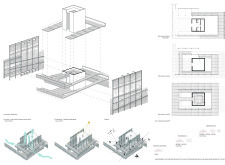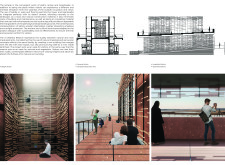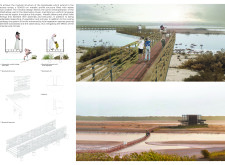5 key facts about this project
The Al Wathba Wetlands Observatory is located in Abu Dhabi, functioning as a space for observing and understanding the surrounding wetlands. The design emphasizes the connection between cultural and natural elements, highlighting local heritage while also focusing on sustainability. Inspiration is drawn from traditional Arabic architecture, particularly Wind Catchers and Temples, which guide the overall concept and layout of the observatory.
Site Integration
The design encourages visitors to explore the wetlands through a network of paths, ramps, and boardwalks. At the center, a large oculus creates a focal point, facilitating movement and interaction throughout the structure. This arrangement allows visitors to experience different perspectives of the landscape, making the environment an integral part of the journey.
Material Considerations
Adobe is used in crafting the walls and flooring, chosen for its ability to insulate and maintain comfortable temperatures inside. This material reflects the local context and minimizes the ecological footprint, sticking to the principles of sustainable building practices. It enhances the overall experience by providing a pleasant atmosphere in hot weather.
Cultural Reinterpretation
The observatory features lattice wooden Mashrabiya, a traditional design element that is adapted for modern usage. This feature aids in allowing air to flow through while controlling sunlight, which enhances comfort for visitors. By incorporating the Mashrabiya, the design honors cultural traditions while addressing contemporary needs.
Architectural Detailing
Every aspect of the observatory's design showcases attention to detail. The central oculus acts as both a light source and a guiding element, making the experience of navigating the observatory meaningful. It frames the views of the wetlands beautifully, connecting visitors to the ecological richness of the site. This thoughtful detailing enriches the overall architectural experience, establishing a dialogue between the structure and its natural surroundings.






















































